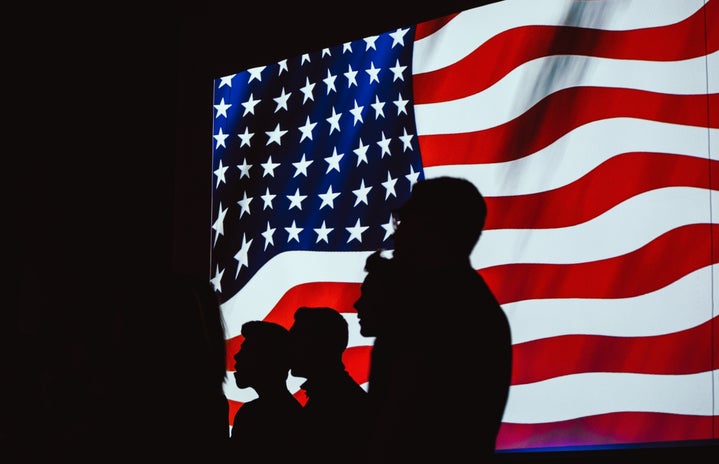“Facing It”
My black face fades,
hiding inside the black granite.
I said I wouldn’t
dammit: No tears.
I’m stone. I’m flesh.
My clouded reflection eyes me
like a bird of prey, the profile of night
slanted against morning. I turn
this way—the stone lets me go.
I turn that way—I’m inside
the Vietnam Veterans Memorial
again, depending on the light
to make a difference.
I go down the 58,022 names,
half-expecting to find
my own in letters like smoke.
I touch the name Andrew Johnson;
I see the booby trap’s white flash.
Names shimmer on a woman’s blouse
but when she walks away
the names stay on the wall.
Brushstrokes flash, a red bird’s
wings cutting across my stare.
The sky. A plane in the sky.
A white vet’s image floats
closer to me, then his pale eyes
look through mine. I’m a window.
He’s lost his right arm
inside the stone. In the black mirror
a woman’s trying to erase names:
No, she’s brushing a boy’s hair.
A Walking Memorial
Yusef Komunyakaa explores the idea of cultural memory through memorials and the ambivalence they hold in his poem, “Facing It”. He draws on his own experience as a Vietnam veteran to describe to the reader what a visit to the memorial is like. His poem builds off the brutal end of the Vietnam War that left thousands of dead bodies with no victory to justify them. His work pushes the question, does the memorial honor the dead or does it glorify a pointless war?
No group could have a more complex reaction to the memorial than the Black veteran because this personal and political question is caught in a messy intersection. It is a privilege to be able to separate your political and racial identity and that very privilege sets a tone of isolation and hostility between Black veterans and the rest of America. In Komunyakaa’s poem, he explores his reaction to the Vietnam Veterans Memorial as a Black veteran through imagery of permanence and impermanence. He highlights both the pain memorials represent for veterans and the unity they bring amongst citizens.
Throughout “Facing It” Komunyakaa describes the different components of his identity and experiences as a veteran by looking at what lasts and what is fleeting. He starts breaking down his identity by emphasizing his race in the opening line, “my black face fades” (1). This lets the reader pause to think about how white and Black veterans are treated differently. America has a history of excluding the names of people of color that served and died for the country. The memorial itself is made from black reflective granite so the idea of his face fading amongst the names listed makes sense. The names carved into the wall are permanent, but his reflection will vanish once he walks away. He can distract himself with daily life but eventually, he must come back and face the fact he was in a war.
This theme is continued in the next line, “hiding inside the black granite” (2). What could Komunyakaa possibly be hiding? What does he not want to face? There is a battle between his humanity and the soldier hiding inside him forcing the emotions down. Line three and four, “I said I wouldn’t / dammit: No tears”, alludes to a promise he made to himself but is on the verge of breaking. “No tears” specifically refers to what the soldier wants. He will not allow emotional processing, vulnerability, or tears. However, facing the memorial lets his flesh win. The battle and emotions that have been hiding are welling up and are about to come out. He told himself he would not give in to his excruciating reality. Facing the memorial means losing emotional control.
The veterans who died are gone and, in a way, are at peace with themselves. Similarly, the families and tourists that come to the memorial only must reflect on the war for as long as they stand there. But for Komunyakaa, his identity makes him a walking memorial. It reminds him of the permanence of the war in a more personal way than what a civilian would experience. The dichotomy presented in the next line perfectly illustrates this, “I’m stone. I’m flesh” (5). The stone refers to the soldier in him, the memorial itself, the war, and the deaths from it. The flesh on the other hand refers to his fleeting emotions, the traumatic memories, and the physical tears he referenced earlier. His body, his memories, and his tears will all pass away eventually, but as the memorial so clearly reminds him, the war itself and the carnage left behind never will. The opening of his poem is an invitation to look at the world through his eyes and explore how the human experience is full of permanence and impermanence.
As the poem progresses, Komunyakaa explores another aspect of his identity, being a veteran, and how that affects his interaction with the memorial. In lines 14-16, he says, “I go down the 58,022 names / half expecting to find / my own in letters like smoke” . A memorial’s purpose is to commemorate or honor the actions of an individual or group. Oftentimes, memorials are described as never letting us forget. Without a memorial, the thing society wants to be made permanent would be forgotten or ignored. It’s society’s way of holding on to something.
The physical monument sets an unmovable mark in cultural memory for at least those who visit. The irony here is that veterans do not need a memorial to remember the war. This section uses a simile to describe his interaction with the physical memorial that represents the battle between the idea of being permanent and fleeting. The letters on the memorial are carved and therefore are lasting. However, smoke is temporary and eventually fades away. We often think of smoke as a signal or a sign of something bigger, usually a fire. In Komunyakaa’s situation, the “letters like smoke” point toward the names of those who lost their lives in the war. The smoke leads you to the fire, the names lead you to the reality of the dead veterans and their sacrifice. Komunyakaa or any veteran for that matter is a walking memorial. How are they being honored?
It seems the emphasis is put on the dead, yet he must carry the permanent weight and trauma of war. So, it is no surprise that he is half-expecting to see his name on the list because part of him died in the war. Any life after war must surely be distorted and rot with unwanted memories so disruptive that you feel you have lost part of your life. Komunyakaa expands more on his identity and shows the reader his complex relationship with the memorial.
Komunyakaa shifts his focus at the end of the poem from his personal experience with the memorial to how memorials can bring people together. The last lines say, “In the black mirror / a woman’s trying to erase names: / No, she’s brushing a boy’s hair” (29-31). The black mirror represents not only the literal black granite, but his race. Komunyakaa yet again reminds the reader that for him, the experience with this memorial, with the war, and the complex political and social questions are all interconnected. He cannot be seen as just a veteran because he is also Black, and in turn, is treated differently thus creating a hostile and isolated existence.
Both war and memorials are political statements. Whiteness is a forgotten piece of identity that can be ignored, but for people of color, race has become politicized. He sees a woman trying to erase names. The word erase carries much weight in this line. It implies wanting to get rid of, wanting to forget, or even wanting to remove a mistake. This reflects how Komunyakaa’s initial reaction to the public is one of hostility. He feels that they can live full lives, ones that are not wrecked with trauma from war or racism. However, the last line is a seed of hope. It is a moment of correction. He openly denies his previous thoughts and sees the woman for what she is really doing, brushing a boy’s hair. This is a nurturing gesture.
Komunyakaa stops the poem here but as the reader, you are left to speculate. Are the woman and the child there to mourn the loss of a family member? Do they suffer from carrying around the weight of war just like Komunyakaa? For the entire poem, Komunyakaa is isolated and alone struggling with the complexities of his multiple identities and how they relate to the memorial. Not until the end does he realize that he is not alone and that memorials also can represent unity. This unity could also be seen as healing, a way for him to let go of this hostile lens through which he sees the world. Memorials can make a society swear they will never forget and that they will always carry some of the weight. While Komunyakaa still has the right to criticize both society and the war, he does not have to feel so alone. He also realizes that for the thousands of dead soldiers, there are thousands of families who are processing just like him. While this memorial is imperfect, it still can unify people and bring about healing.
Komunyakaa guides the reader through his experience as a Black veteran visiting the Vietnam Vetera’s Memorial. He shows the reader that for a veteran, you do not need to visit a memorial to remember war. It is permanently ingrained in you. He explains how the emotions associated with mourning and processing are unpredictable and fleeting. The complex social and political questions represented in memorials can lead to feelings of isolation and hostility.
He served and made huge sacrifices for a country that denies him basic rights and constantly discriminates against him. Looking back at the title, Komunyakaa quite literally confronts his feelings of “me against the world.” However, Komunyakaa challenges readers at the end with his push for reconciliation. He acknowledges that while his feelings are valid, reconciliation is a way society can move forward and have difficult conversations about how to memorialize well. He pushes the reader to acknowledge that you can still honor sacrifices while criticizing the war and broken systems of the country. Cultural memory is pliable. Works like this help us not forget the perspectives that are often left out and in turn unite us as a people


